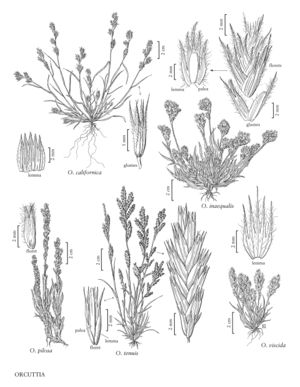Difference between revisions of "Orcuttia viscida"
imported>Volume Importer |
imported>Volume Importer |
||
| Line 41: | Line 41: | ||
|publication year= | |publication year= | ||
|special status=Endemic | |special status=Endemic | ||
| − | |source xml=https://bitbucket.org/aafc-mbb/fna-data-curation/src/ | + | |source xml=https://bitbucket.org/aafc-mbb/fna-data-curation/src/200273ad09963decb8fc72550212de541d86569d/coarse_grained_fna_xml/V25/V25_472.xml |
|subfamily=Poaceae subfam. Chloridoideae | |subfamily=Poaceae subfam. Chloridoideae | ||
|tribe=Poaceae tribe Orcuttieae | |tribe=Poaceae tribe Orcuttieae | ||
Latest revision as of 18:58, 11 May 2021
Plants pilose, very viscid, strongly aromatic. Culms 3-10(15) cm, simple, erect, often spreading in age. Leaves usually without a "collar" line; blades 2-4 mm wide. Spikes 3-5 cm, somewhat congested (less so than those of O. inaequalis); lower and upper internodes 3-7 mm. Spikelets with 6-20(30) florets. Glumes subequal, 5-6 mm, unequally 3-toothed, teeth as long as the bodies, awn-tipped; lemmas 6-7 mm, teeth as long as the lemma bodies, central tooth evidently the longest, awns at least 1 mm; paleas at least 3/4 as long as the lemmas; anthers about 2 mm. Caryopses 2.3-2.5 mm, broadly elliptical; embryos about as long as the caryopses. 2n = 28.
Discussion
Orcuttia viscida grows at elevations below 120 m in Sacramento County, California. Its awn-tipped lemma teeth curve outward at maturity, giving the spikes a distinctive, bristly appearance. It is listed as an endangered species by the U.S. Fish and Wildlife Service.
Selected References
None.
